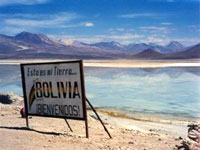Visit worldtravels.com for the full guide to Bolivia. Build a complete Bolivia travel guide and email to your clients - sign up for a trial subscription of World Travels Pro.
Bolivia

Bolivia is known as the 'Tibet of the Americas', the highest and most remote of the countries in South America. It is a landlocked region with two Andean mountain ranges binding the Altiplano, or High Plain, between them. This plain has an altitude ranging from 9,000 to 13,000 feet (3,000 to 4,000m), and is where the majority of the population lives.
The history of the region dates back to the pre-Columbian times, from the ancient Aymará civilisation in 1500 BC who lived on Lake Titicaca, to the Tiahuanaco and the Inca Empire of the Altiplano, until the conquest of the Spanish in 1538. Traces of these civilisations are evident in the architecture of the colonial cities, displayed in informative museums that can be visited at the sites of ancient ruins.
Bolivia is one of South America's most intriguing countries, as the nation with the most concentrated indigenous population on the continent, the majority of whom still maintain their traditional culture and beliefs. This living historical culture is one of the reasons that Bolivia is such an exciting and increasingly-popular tourist destination. The landscape is imbued with traditional houses and age-old methods of agriculture, and visitors will find remarkable traditions kept alive in the ancient techniques of weaving, handcraft and food production. The sounds of this cultural legacy echo in the haunting melodies of the panpipes from the high Altiplano or in the lively tunes emanating from the warmer lowlands.
The dramatic geography affords many adventure opportunities: explorers can track wildlife in the Amazonian basin, drive across the surreal landscape of the Salar de Uyuni, take a boat trip on the world's highest navigable lake, Titicaca, scramble through muddy shafts in the silver mines of Potosi, or hike in the magnificent Andes mountains. There is enough diversity to meet many tastes.
A holiday in Bolivia is a juxtaposition of extraordinary altitudes and spectacular landscapes, fascinating remains of ancient civilisations, a rich indigenous culture and vast colonial treasures.
Climate
Due to the altitude, Bolivia's weather features a fairly temperate climate, with cold nights and warm days. Temperatures get down to freezing on winter nights. Rain is likely over the summer months (November to March).
Money
The official currency is the Boliviano (BOB), which is divided into 100 centavos, and is tied to the US Dollar. Money can be exchanged at exchange bureaux called casio de cambiosin the main centres, at banks and hotels. Banking facilities are good in the main cities and ATMs cater for Visa, Cirrus and MasterCard. Many hotels and other tourist-oriented institutions accept US Dollars. Major credit cards, including MasterCard, Diners, Visa and American Express, are accepted in the bigger hotels, restaurants and shops. Travellers cheques can be exchanged in casio de cambiosin the major cities and are best taken in US Dollars to avoid additional charges.
Passport Visa
All visitors that require a visa must hold a passport valid for at least six months beyond the length of stay; if no visa is required then only a passport valid on entry to Bolivia is necessary. All visitors travelling by air should also have return tickets and all required documents for next destination as well as sufficient funds to see them through their stay. All travellers arriving from Brazil or Paraguay must show valid Yellow Fever vaccination certificates on entry to Bolivia.
Entry Requirements
- US nationals must have a passport and a visa to enter Bolivia. A visa is obtainable on arrival for a stay of no more than 90 days.
- UK Nationals holding valid passports do not need a visa for stays of up to 90 days for holders of British passports.
- Canadians require a valid passport, but a visa is not necessary for touristic stays of up to 90 days.
- Australians need a passport, but do not require a visa for touristic stays of up to 90 days.
- South Africans require a passport valid for six months and a visa to enter Bolivia. Visas can be issued on arrival for a maximum stay of 90 days for a fee of US$52.
- Irish nationals need a passport, but do not require a visa for touristic stays of up to 90 days.
- New Zealanders need a passport, but do not require a visa for a touristic stay of up to 90 days.
Health
Altitude sickness is the most common complaint in Bolivia with much of the country lying above 10,000ft (3,050m). This is particularly relevant to diabetics, those with heart complaints or chest problems, who should seek advice before travelling to Bolivia. Take Acetazolamide (Diamox) or drink coca tea to alleviate symptoms. A yellow fever vaccination is strongly advised, as outbreaks do occur, particularly after flooding, and it is a requirement for those entering from infected areas. Malaria is prevalent in some parts of the country, and dengue fever is on the increase. Sanitation and hygiene are poor in some areas so be wary of what is eaten; avoid under-cooked meat and unpeeled fruit and vegetables, and only drink bottled water. Medical insurance is strongly recommended.
Embassy Consulates
- Bolivian Embassy, Washington DC, United States: +1 202 232 4827.
- Bolivian Embassy, London, United Kingdom (also responsible for Ireland): +44 (0)20 7235 4248.
- Bolivian Embassy, Vancouver, Canada: +1 604 922 3474.
- Bolivian Consulate, Sydney, Australia: +61 (0)2 9241 4235.
- Honorary Consulate of Bolivia, Johannesburg, South Africa: +27 (0)11 883 3416.
Foreign Embassies
- United States Embassy, La Paz: +591 (2) 216 8000.
- British Embassy, La Paz: +591 (2) 243 3424.
- Canadian Embassy, La Paz: +591 (2) 241 5141.
- Australian Consulate, La Paz: +591 7061 0626
- South African Embassy, Lima, Peru (also responsible for Bolivia): +51 (0)1 440 9996.
- Consulate of Ireland, La Paz: +591 (2) 241 1873.







